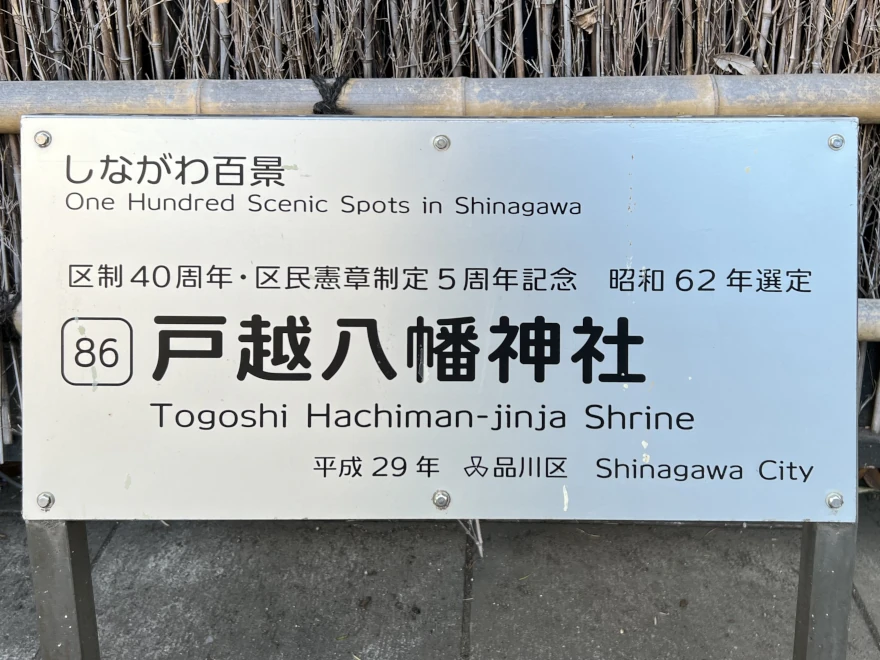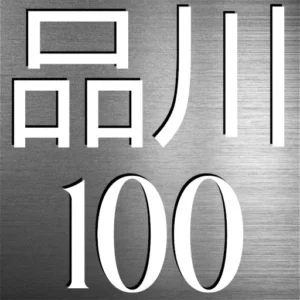Togoshi Hachiman-jinja – A Shrine at the Edge of Edo
⛩ A Village Shrine That Still Anchors the Community
Togoshi Hachiman-jinja Shrine (戸越八幡神社) has stood watch over this part of Shinagawa since 1526 (Daiei 6). According to shrine tradition, a traveling monk named Gyōei discovered a sacred statue of the deity Hondawake no Mikoto (誉田別命)—the deified Emperor Ōjin—at a spring known as Yabushimizu. Gyōei built a simple thatched hut and enshrined the spirit along with a divided essence (分霊) from Kyoto’s Iwashimizu Hachiman-gū. That hut became known as Jōjū-an.
Local belief quickly grew that prayers made here were granted. An old waka poem expresses this hope:
“Past Edo, atop the spring, Jōjū-an remains —
Where no thread of hope goes unanswered.”
As the area developed, the nearby temple Gyōkei-ji helped establish a formal shrine structure in the late 1500s. The shrine moved to its current site in 1688 (Genroku 1), and the main hall was rebuilt using zelkova wood in 1855 (Ansei 2). The structure still stands today, making it one of the oldest surviving buildings of its kind in the ward.
📛 The Origins of “Togoshi”
The shrine didn’t name the town—but its presence helped shape the story. According to local tradition, the term “Edo-goe” (江戸越え), meaning “beyond Edo,” described this once-rural village just outside the capital’s edge. Over time, the phrase shifted in pronunciation: Edo-goe → Togoe → Togoshi. The early spiritual fame of Jōjū-an likely helped fix the place in memory and map.
🧭 A Stop on the Tokyo Fuku Meguri Tour
Togoshi Hachiman is one of eight shrines on the Tokyo Fuku Meguri—a good luck pilgrimage along the Toei Asakusa Line. The tour connects historic shrines like Asakusa, Tsukiji, and Takanawa with lesser-known gems such as this one. Pilgrims collect special stamps at each stop. While the route is modern, the connection it fosters between communities and shrines like Togoshi Hachiman is timeless.
The shrine also embraces local events. It hosts book and miniature book fairs, continues seasonal rituals like the summer purification ceremony (Nagoshi-no-Ōharae), and draws families during its autumn festival. In earlier decades, the grounds even featured kagura dance and local sumo matches during festival time.
Tucked behind a residential street, Togoshi Hachiman is easy to miss. But like many Tokyo shrines, it rewards those who pause and step inside.
🗺️ Tokyo Fuku Meguri – All Eight Shrines
The Tokyo Fuku Meguri (東京福めぐり) connects eight shrines along the Toei Asakusa Line. Each shrine is linked by the theme of good fortune. Here’s the full list:
- 1. Asakusa Shrine (浅草神社) – Asakusa Station
- 2. Kuramae Karasue Shrine (烏越神社) – Kuramae Station
- 3. Fukutoku Shrine (福徳神社) – Nihonbashi Station
- 4. Namiyoke Shrine (波除神社) – Higashi-Ginza Station
- 5. Karasumori Shrine (烏森神社) – Shimbashi Station
- 6. Takanawa Shrine (高輪神社) – Sengakuji Station
- 7. Togoshi Hachiman Shrine (戸越八幡神社) – Togoshi Station (this spot)
- 8. Kami-shinmei Tenso-jinja Shrine (上神明天祖神社) – Nakanobu Station
⛩ Togoshi Hachiman-jinja Shrine Details
- Enshrined Deity: Hondawake no Mikoto (誉田別命) – the deified Emperor Ōjin, guardian of cultural growth and protection
- Founded: 1526 (Daiei 6)
- Affiliation: Branch of Iwashimizu Hachiman-gū (Kyoto)
- Main Hall: Built in 1855 (Ansei 2), zelkova-wood construction
- Preserved Artifacts: Ritual palanquin chest (1770), sacred mats (1785, 1789), Edo-period ema and komainu
- Annual Events: September Grand Festival, summer purification rites (Nagoshi-no-Ōharae), New Year prayers
- Special Role: Participates in the Tokyo Fuku Meguri pilgrimage
🧭 Visitor Information
Address: 2-6-23 Togoshi, Shinagawa-ku, Tokyo 142-0041
Access: 5-minute walk from Togoshi Station (Toei Asakusa Line) or Togoshi-Ginza Station (Tokyu Ikegami Line)
Best time to visit: September during the autumn festival, or on a calm weekday morning
Admission: Free
Official Info: togoshihachiman.jp
Where is it?
| what3words | ///invented.system.pixies |
| latitude longitude | 35.612939, 139.72006 |
| Nearest station(s) | Togoshi Station (Asakusa Line) Togoshi-Ginza Station (Ikegami Line) Togoshi Koen Station (Oimachi Line) |
| Nearest public conveniences | Nearby parks or Togoshi Ginza shopping arcade |
Show me a sign.

The Hyakkei sign is installed on the approach path, near the entrance torii.
Withervee says…
This is one of those places that feels familiar, even on your first visit. The path is clean, the trees are tall and give lots of shade, and the shrine buildings are well-kept but not showy. There’s no tourist buzz here – just neighbors passing through, or pausing to bow. If you’re walking the Tokyo Fuku Meguri, it’s a quiet stop that rewards your attention.
Site Character
- Lifestyle 生活 (Seikatsu): ✔️
- Historical Significance 歴史 (Rekishi): ✔️
- Atmosphere/Natural Features 風土 (Fūdo): ✔️
Who in their right mind would vote for this?
- Shinto pilgrims
- Local historians
- Neighbourhood walkers
- Festival photographers
- Architecture buffs
Further reading
https://togoshihachiman.jp (Japanese)
Tokyo Fuku Meguri – Asakusa jinja (Japanese)
While you’re there…
Don’t miss wandering down Togoshi Ginza Shopping Street, one of Tokyo’s longest and liveliest shopping arcades.
Next
87: Togoshi Park

